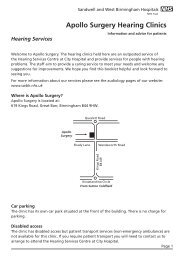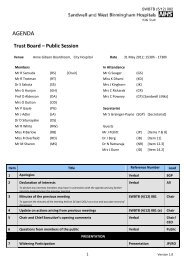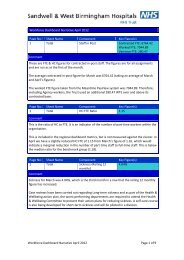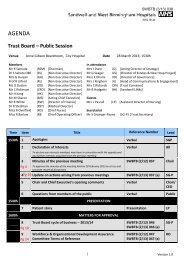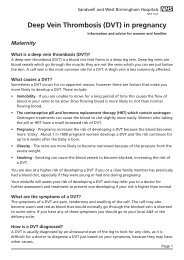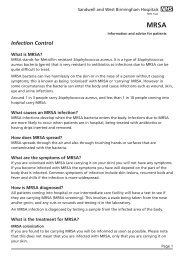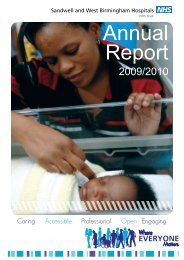The latent phase of labour - Sandwell & West Birmingham Hospitals
The latent phase of labour - Sandwell & West Birmingham Hospitals
The latent phase of labour - Sandwell & West Birmingham Hospitals
Create successful ePaper yourself
Turn your PDF publications into a flip-book with our unique Google optimized e-Paper software.
<strong>The</strong> <strong>latent</strong> <strong>phase</strong> <strong>of</strong> <strong>labour</strong>:<br />
how to recognise what is<br />
happening and how to cope<br />
Information and advice for mothers-to-be<br />
Maternity
What is the <strong>latent</strong> <strong>phase</strong> <strong>of</strong> <strong>labour</strong>?<br />
When you reach the end <strong>of</strong> your pregnancy it is normal to feel<br />
apprehensive or even excited about the start <strong>of</strong> <strong>labour</strong>. Before<br />
<strong>labour</strong> starts, the neck <strong>of</strong> the womb (cervix) is long, firm and closed<br />
but this changes in the last few weeks <strong>of</strong> pregnancy.<br />
<strong>The</strong> <strong>latent</strong> <strong>phase</strong> <strong>of</strong> <strong>labour</strong> is the build up period<br />
before the start <strong>of</strong> <strong>labour</strong>. During the <strong>latent</strong> <strong>phase</strong><br />
the neck <strong>of</strong> your womb (cervix) thins and opens up<br />
(dilates) to 4 cm.<br />
As the cervix stretches and fits around the baby’s<br />
head you will experience some sharp pains - this<br />
is normal. Some <strong>of</strong> these pains can be quite sharp<br />
or even feel strong however they do not mean that <strong>labour</strong> is about<br />
to start – they are known as Braxton Hicks contractions. You might<br />
find that you have a ‘show’ (lose the mucus plug),<br />
which is likely to happen anytime from 37-42<br />
weeks during your pregnancy. <strong>The</strong> show can look<br />
like the mucus that is on a tissue when you blow<br />
your nose, sometimes it has streaks <strong>of</strong> blood in it.<br />
Mucus plug This is all part <strong>of</strong> the normal build up to <strong>labour</strong>.<br />
Once the <strong>latent</strong> <strong>phase</strong> <strong>of</strong> <strong>labour</strong> has done its work you will go into<br />
the first active stage <strong>of</strong> <strong>labour</strong>; this is when <strong>labour</strong> has become<br />
‘established’.<br />
How do I recognise the <strong>latent</strong> <strong>phase</strong> <strong>of</strong> <strong>labour</strong>?<br />
cervix stretching<br />
around baby’s head<br />
Some women can feel backache or cramps during this time and<br />
even have bouts <strong>of</strong> contractions lasting a few hours which then stop<br />
and start up again the next day. This is normal and can last on and<br />
<strong>of</strong>f for days and might be very tiring for you.<br />
2
How can I manage the <strong>latent</strong> <strong>phase</strong> <strong>of</strong> <strong>labour</strong>?<br />
<strong>The</strong> best place for you to be during the <strong>latent</strong> <strong>phase</strong> <strong>of</strong> <strong>labour</strong> is at<br />
home where you can feel more comfortable and relaxed.<br />
Tips to help you cope<br />
• Keep active – Moving around will help your <strong>labour</strong> to progress<br />
normally, so do some light housework or take the children or<br />
dog for a walk.<br />
• Eat and drink as normal – It is important to keep your energy<br />
up so eat some small snacks that are high in calories and drink<br />
plenty <strong>of</strong> water.<br />
• Make sure that you are going to the toilet normally – If you have<br />
emptied your bowels frequently it can help <strong>labour</strong> to start.<br />
• Rock your pelvis and sway your hips – This can help you manage<br />
the pain. If you have access to a birthing ball, use it regularly as<br />
this too can alleviate any discomfort.<br />
• Have lots <strong>of</strong> warm baths – Warm water is very soothing when<br />
you have this sort <strong>of</strong> discomfort.<br />
• Put your TENS unit on – If you have decided to use one <strong>of</strong> these<br />
you will have had instructions on how to apply it.<br />
• Use massage and aromatherapy oils – <strong>The</strong>se can help you to<br />
relax and sleep between the tightenings.<br />
• Use relaxation, breathing or hypnobirthing techniques – If you<br />
have been practising these techniques they will help to relax and<br />
manage the discomfort at this time.<br />
• Take 2 Paracetamol (500mg) tablets and repeat 4 hourly – do not<br />
exceed 8 tablets in 24 hours.<br />
• Make love – kissing, cuddling and having an orgasm all cause<br />
your body to produce the <strong>labour</strong> hormone oxytocin. Oxytocin<br />
is the hormone that makes the muscles in the womb contract<br />
strongly.<br />
3
You may also want to call your birthing partner for added support<br />
during this time. S/he will give you support and reassurance to help<br />
reduce your anxiety. Your birthing partner can also make other<br />
family members aware that you are in the <strong>latent</strong> <strong>phase</strong> <strong>of</strong> <strong>labour</strong><br />
and encourage them to give you support rather than raise concerns.<br />
What is the difference between <strong>labour</strong> contractions and<br />
Braxton Hicks contractions?<br />
‘Braxton Hicks’ contractions occur throughout pregnancy. <strong>The</strong>y<br />
are tightening <strong>of</strong> the muscles <strong>of</strong> the uterus and last for about<br />
30 seconds. <strong>The</strong>y are usually painless but might feel tight and<br />
uncomfortable. <strong>The</strong>y do not harm the baby. During the <strong>latent</strong> <strong>phase</strong><br />
<strong>of</strong> <strong>labour</strong>, Braxton Hicks contractions may become more noticeable<br />
and more frequent, lasting between 30 and 45 seconds.<br />
You ARE NOT having <strong>labour</strong> contractions when:<br />
• the contractions are irregular and short lasting<br />
• the contractions do not get closer together<br />
• walking or changing your position does not affect the<br />
contraction<br />
• they reduce in strength<br />
• resting may stop them<br />
• you feel them in the front and groin area<br />
You ARE having <strong>labour</strong> contractions when:<br />
• the tightenings become more frequent and regular<br />
• they are at least every 3-4 minutes and last for more than 1<br />
minute<br />
• they feel stronger and painful<br />
4
When you are having <strong>labour</strong> contractions you might find that you<br />
need to use the toilet a lot – this is because your body is getting<br />
ready for <strong>labour</strong>.<br />
Uterus between<br />
contractions<br />
Uterus during<br />
contractions<br />
When should I come into hospital/the birth centre?<br />
<strong>The</strong> best place for you to be during the <strong>latent</strong> <strong>phase</strong> <strong>of</strong> <strong>labour</strong> is<br />
at home. You are more relaxed during the <strong>latent</strong> <strong>phase</strong> <strong>of</strong> <strong>labour</strong><br />
at home and then you will move into the 1st stage <strong>of</strong> <strong>labour</strong><br />
more quickly. You should call us when you feel that your <strong>labour</strong> is<br />
progressing into the 1st stage (you are having <strong>labour</strong> contractions as<br />
described above) to let us know that you are coming into hospital/<br />
the birth centre.<br />
If you have tried all <strong>of</strong> the tips and ways to cope at home and feel<br />
anxious or you are in more pain than you expected then contact us<br />
for advice.<br />
If you are invited to go into the hospital then take an overnight bag<br />
with you. When you arrive you will have a thorough examination<br />
to determine whether your <strong>labour</strong> has established or not. If your<br />
<strong>labour</strong> has not yet established you may be asked to return home,<br />
because this is the best place for you to be during the <strong>latent</strong> <strong>phase</strong>.<br />
5
You should come into Triage in the Maternity Unit at City Hospital<br />
if:<br />
• your waters break and are stained (green or black colour)<br />
• you are bleeding fresh blood<br />
• your baby has not moved the way it normally does during the<br />
last 24 hours<br />
Contact details<br />
If you are high risk<br />
Triage: 0121 507 4181<br />
If you are low risk<br />
Serenity Birth Centre: 0121 507 5655<br />
Further information<br />
For more information about <strong>labour</strong>, birth and how to cope please<br />
see the leaflet ‘Labour: what happens and how it can be managed’.<br />
You can also find more information about our Maternity services<br />
and other leaflets about pregnancy and birth on the maternity<br />
pages <strong>of</strong> our website:<br />
<strong>Sandwell</strong> and <strong>West</strong> <strong>Birmingham</strong> <strong>Hospitals</strong> NHS Trust<br />
www.swbh.nhs.uk<br />
6
Sources used for the information in this leaflet<br />
• National Institute for Health and Clinical Excellence, CG55<br />
‘Intrapartum care’, September 2007<br />
• Royal College <strong>of</strong> Midwives Midwifery practice guideline, ‘Latent<br />
<strong>phase</strong>’, May 2008<br />
7
If you would like to suggest any amendments or improvements to this leaflet<br />
please contact the communications department on 0121 507 5420 or email:<br />
swb-tr.swbh-gm-patient-information@nhs.net<br />
A Teaching Trust <strong>of</strong> <strong>The</strong> University <strong>of</strong> <strong>Birmingham</strong><br />
Incorporating City, <strong>Sandwell</strong> and Rowley Regis <strong>Hospitals</strong><br />
© <strong>Sandwell</strong> and <strong>West</strong> <strong>Birmingham</strong> <strong>Hospitals</strong> NHS Trust<br />
ML3538<br />
Issue Date: January 2012<br />
Review Date: January 2014




